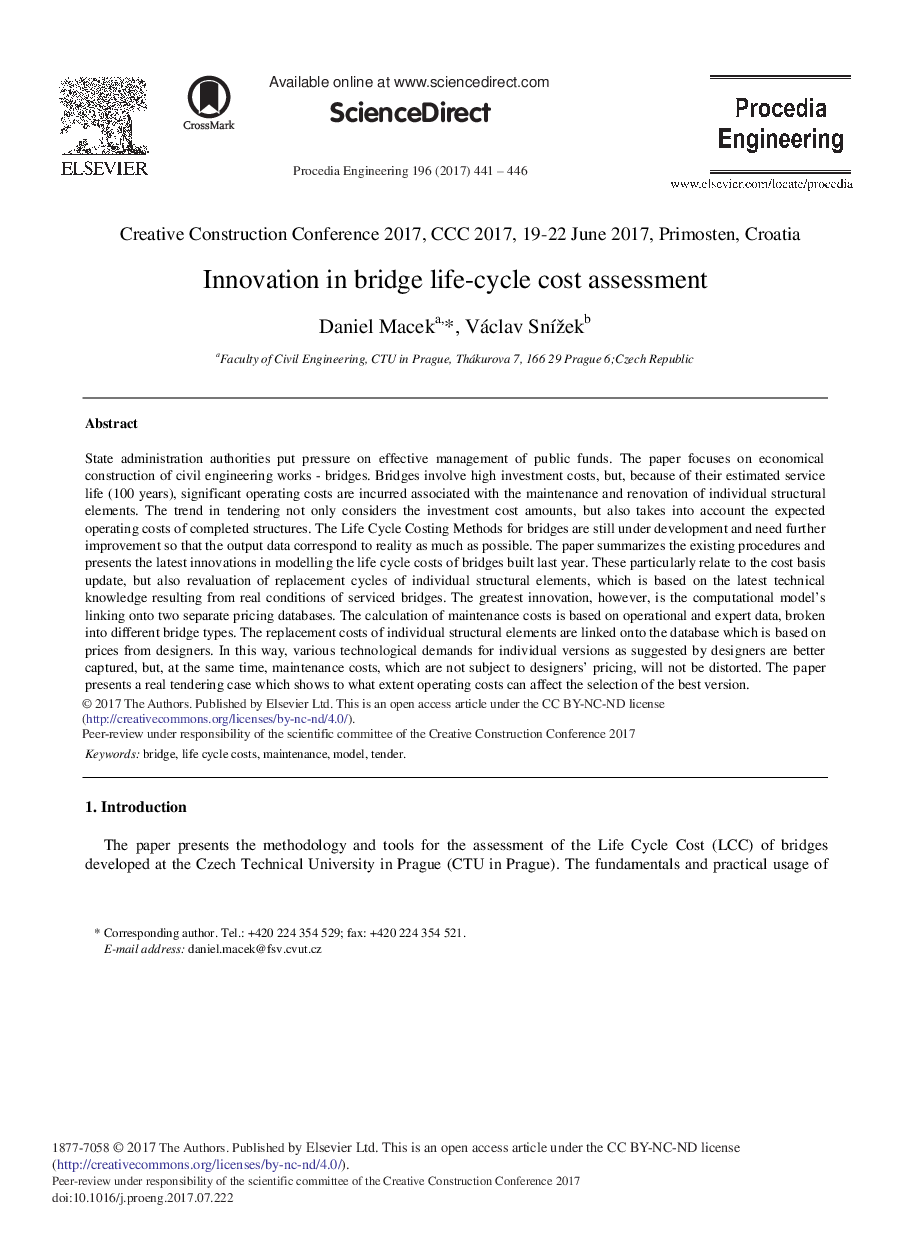| کد مقاله | کد نشریه | سال انتشار | مقاله انگلیسی | نسخه تمام متن |
|---|---|---|---|---|
| 5026970 | 1470630 | 2017 | 6 صفحه PDF | دانلود رایگان |
عنوان انگلیسی مقاله ISI
Innovation in Bridge Life-cycle Cost Assessment
ترجمه فارسی عنوان
نوآوری در ارزیابی هزینه زندگی چرخه پل
دانلود مقاله + سفارش ترجمه
دانلود مقاله ISI انگلیسی
رایگان برای ایرانیان
کلمات کلیدی
پل هزینه های چرخه حیات، نگهداری، مدل، مناقصه،
ترجمه چکیده
مقامات دولت ایاالت متحده بر مدیریت موثر بودجه عمومی فشار می آورند. این مقاله بر روی ساخت و ساز اقتصادی کارهای مهندسی عمران - پل ها تمرکز دارد. پل ها شامل هزینه های سرمایه گذاری بالایی هستند، اما به دلیل طول عمر تخمینی آنها (100 سال)، هزینه های عملیات قابل توجهی در ارتباط با نگهداری و بازسازی عناصر ساختاری فردی ایجاد می شود. روند تدارکات نه تنها هزینه های سرمایه گذاری را در نظر می گیرد بلکه هزینه های عملیاتی مورد انتظار ساختارهای کامل را نیز در نظر می گیرد. روش هزینه های چرخه زندگی برای پل ها هنوز در حال توسعه است و نیاز به بهبود بیشتر دارد تا داده های خروجی به همان اندازه که ممکن است با واقعیت سازگار باشد. این مقاله روش های موجود را خلاصه کرده و آخرین نوآوری هایی را در مدل سازی هزینه های چرخه زندگی پل های ساخته شده در سال گذشته ارائه می دهد. این به خصوص مربوط به به روز رسانی بر مبنای هزینه است، اما همچنین بازتوزیع چرخه های جایگزینی عناصر ساختاری فردی است که بر اساس آخرین اطلاعات فنی حاصل از شرایط واقعی پل های سرویس می شود. با این حال، بزرگترین نوآوری، پیوند مدل محاسباتی با دو پایگاه داده قیمت گذاری جداگانه است. محاسبه هزینه های تعمیر و نگهداری براساس اطلاعات عملیاتی و متخصص است که به انواع پل های مختلف تقسیم می شوند. هزینه های جایگزینی عناصر ساختاری فردی به پایگاه داده مربوط می شود که بر اساس قیمت طراحی شده است. به این ترتیب، نیازهای تکنولوژیکی مختلفی برای نسخه های فردی که طراحان پیشنهاد می دهند، بهتر است، اما در عین حال، هزینه های تعمیر و نگهداری که به قیمت گذاری طراحان منجر نمی شوند، تحریف نخواهند شد. این مقاله یک پرونده مناقصه واقعی است که نشان می دهد که چه مقدار هزینه های عملیاتی می تواند بر انتخاب بهترین نسخه تأثیر بگذارد.
موضوعات مرتبط
مهندسی و علوم پایه
سایر رشته های مهندسی
مهندسی (عمومی)
چکیده انگلیسی
State administration authorities put pressure on effective management of public funds. The paper focuses on economical construction of civil engineering works - bridges. Bridges involve high investment costs, but, because of their estimated service life (100 years), significant operating costs are incurred associated with the maintenance and renovation of individual structural elements. The trend in tendering not only considers the investment cost amounts, but also takes into account the expected operating costs of completed structures. The Life Cycle Costing Methods for bridges are still under development and need further improvement so that the output data correspond to reality as much as possible. The paper summarizes the existing procedures and presents the latest innovations in modelling the life cycle costs of bridges built last year. These particularly relate to the cost basis update, but also revaluation of replacement cycles of individual structural elements, which is based on the latest technical knowledge resulting from real conditions of serviced bridges. The greatest innovation, however, is the computational model's linking onto two separate pricing databases. The calculation of maintenance costs is based on operational and expert data, broken into different bridge types. The replacement costs of individual structural elements are linked onto the database which is based on prices from designers. In this way, various technological demands for individual versions as suggested by designers are better captured, but, at the same time, maintenance costs, which are not subject to designers' pricing, will not be distorted. The paper presents a real tendering case which shows to what extent operating costs can affect the selection of the best version.
ناشر
Database: Elsevier - ScienceDirect (ساینس دایرکت)
Journal: Procedia Engineering - Volume 196, 2017, Pages 441-446
Journal: Procedia Engineering - Volume 196, 2017, Pages 441-446
نویسندگان
Daniel Macek, Václav SnÞek,
